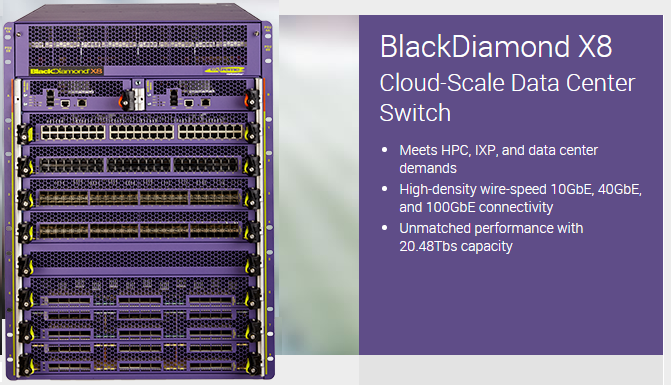Extreme BlackDiamond X8

Announced in 2011. Started shipping in 2012.
100 Gb/s cards accept 4 CFP2 transceivers. A chassis can support up to 32 100-G ports. The only interfaces supported are SR10 and LR4.
This is an 8-slot switch with 20 Tb/s backplane capacity. The data sheet has nothing to say about packet buffers. A FAQ produced in 2011 before the first products were shipped has some info:
23. What will the switch buffer sizes on BlackDiamond X8 switches be?
The I/O modules will support a 9 Mbyte (72 Mbit) packet buffer per 24 x 10 GbE ports or 6 x 40 GbE ports. This means that the 24.port 40 GbE module will have 36 Mbyte, the 12.port 40 GbE and the 48.port 10 GbE modules will have 18 MByte. Each of the switching fabric modules (FM) will support a 36 Mbyte (288 Mbit) packet buffer. This means that the FM packet buffer total will be 144 Mbytes when four FMs are installed.
These are very modest buffers. That there is buffer in the fabric modules is interesting. This may be more useful for multicast replication than it is for buffering large flows.
Note added June 2016
Extreme has a white paper on buffers that was added to their web site in 2014. Extreme reviews the problem of network congestion -- much as this web page does. There is not a lot of exciting new material here. There is a confirmation that the kit is assembled with Broadcom trident silicon. The paper says in its concluding sections that FADT (Fair adaptive Dynamic Threshold) adapts perfectly to a wire range of workloads. But it also says [page 6]:
-
Extreme Networks Summit X670 TOR switch provides 9MB
of smart packet buffer across 48, 10GbE and 4, 40GbE ports.
Similarly, the Extreme Networks Black Diamond X8 utilizes
shared smart buffering technology both on its I/O modules
as well as on its fabric modules or example, the 24-port 40G
module uses four packet processing silicon chips, each of
which provides 9MB (72Mb) of smart packet buffer. A small
number of buffers are reserved on a per-port/per-queue basis,
which is configurable. The rest of the buffers are available as
a shared pool that can be allocated dynamically across ports/
queues.
The paper somewhat over discusses buffer bloat and should not be relied upon in this regard. Owners of Extreme switches should use this psper to get their manufacturer's slant.